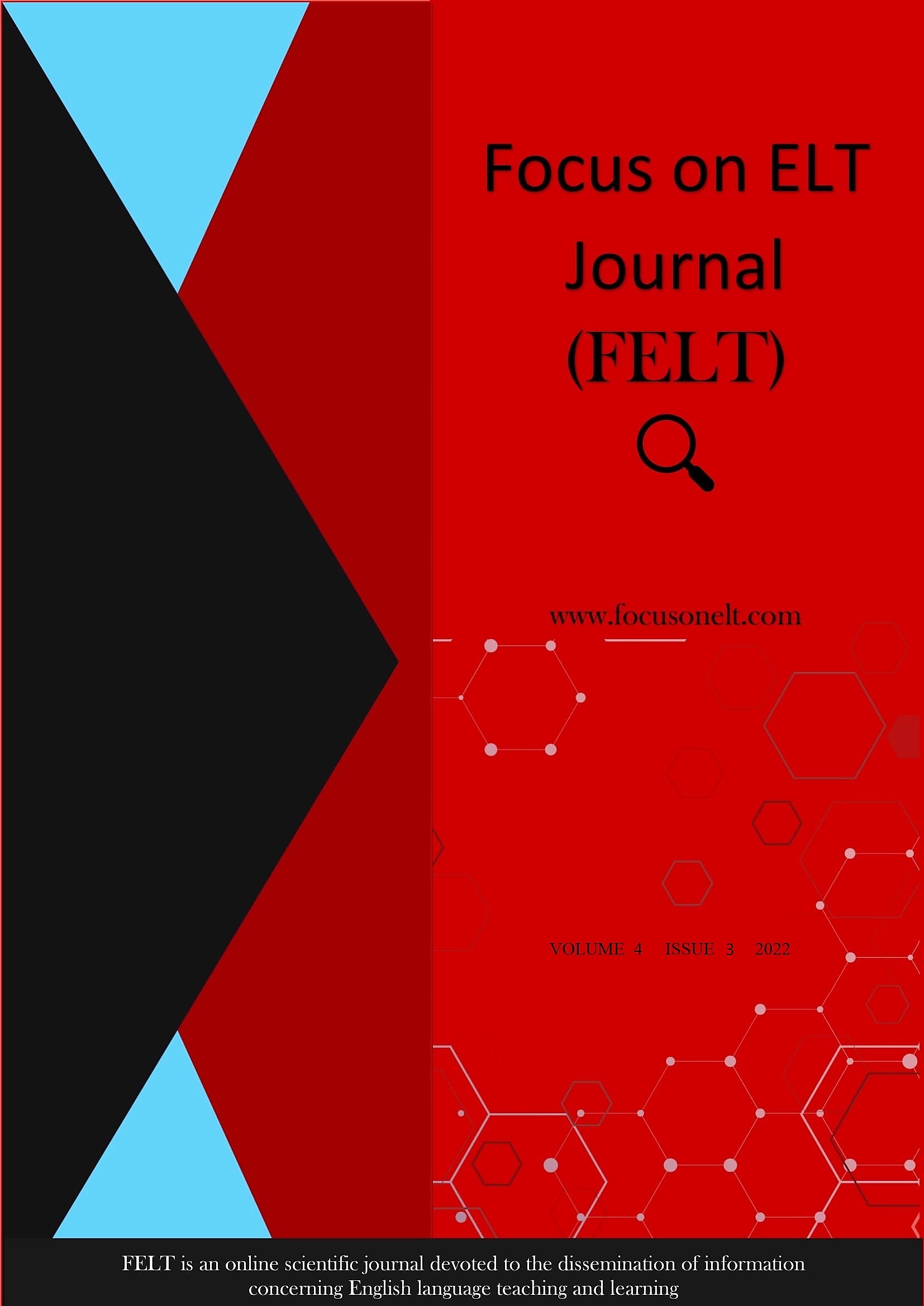Mindfulness-based practices for EFL teachers: sample tasks and insights to cultivate mindfulness
Main Article Content
Abstract
There has been a growing interest in the concept of mindfulness and how it can be used in foreign language (FL) teaching to promote the well-being of both teachers and learners. In FL education, mindfulness is a novel practice, and it can be used as a tool for positive transformation to create enhanced learning environments. Thus, implementing mindfulness into FL teaching and learning may have an effect in the conscious management of reactions to mental and physical events happening in a language classroom and establish a less stressful learning atmosphere. However, FL teachers may lack both knowledge and practical realizations of mindfulness; and hence, need guidance in how mindfulness can be incorporated into their own teaching contexts. Based on this insight, this paper presents the latest findings from mindfulness research in language teaching and offers ways to promote mindfulness in English as a foreign language (EFL) classrooms. For this purpose, several activities including breathing exercises and meditation practices to foster a mindful attitude for teachers are suggested along with mindfulness practices for the development of language skills. Moreover, this study proposes insight into mindfulness-based language teaching with notable implications to enrich FL teaching/learning environments and highlights the importance of integrating mindfulness in FL teacher education.
Metrics
Article Details

This work is licensed under a Creative Commons Attribution-NonCommercial-NoDerivatives 4.0 International License.
References
Baer, R.A., Smith, G.T., Hopkins, J., Krietemeyer, J., & Toney, L. (2006). Using self-report assessment methods to explore facets of mindfulness. Assessment, 13, 27–45.
Caballero, C., Scherer, E., West, M. R., Mrazek, M. D., Gabrieli, C. F., & Gabrieli, J. D. (2019). Greater mindfulness is associated with better academic achievement in middle school. Mind, Brain, and Education, 13(3), 157-166.
Capel, C. M. (2012). Mindlessness/mindfulness, classroom practices and quality of early childhood education: an auto‐ethnographic and intrinsic case research. International Journal of Quality & Reliability Management.
Charoensukmongkol, P. (2016). The role of mindfulness in reducing English language anxiety among Thai college students. International Journal of Bilingual Education and Bilingualism, 22, 414–427.
Chopra, D. (2003). Seven myths of meditation. The Huffington Post, March 9, 2013. https://www.huffpost.com/entry/meditation-myths_b_2823629.
Fallah, N. (2017). Mindfulness, coping self-efficacy and foreign language anxiety: A mediation analysis. Educational Psychology, 37(6), 745-756.
Fulwiler & de Torrijos (2011). Mindfulness and Health. Psychiatry Information in Brief, 8(2), 153-166
Hjeltnes, A., Binder, P. E., Moltu, C., & Dundas, I. (2015). Facing the fear of failure: An explorative qualitative study of client experiences in a mindfulness-based stress reduction program for university students with academic evaluation anxiety. International Journal of Qualitative Studies on Health and Well-being, 10(1), 27990.
Hooker, K. & Fodor, I., (2008) Teaching mindfulness to children. Gestalt Review,12(1), 75 91.
Jenkins, A. (2015). Guided meditation in the English language classroom. English Teaching Forum, 53, 35–38.
Kabat-Zinn, J. (2009). Neredeysen Orada Ol. İstanbul: Kuraldışı Yayınevi.
Kabat-Zinn, J. (2013). Full Catastrophe Living: Using the Wisdom of Your Body and Mind to Face Stress, Pain, and Illness. New York: Bantham Books.
Langer, E. J. (2000). Mindful learning. Current directions in psychological science, 9(6), 220-223.
Larsen-Freeman, D. (2012). Complexity theory: A new way to think. Revista Brasileira de Linguística Aplicada 13(2), 369-373. Doi:10.1590/S1984-63982013000200002
Meiklejohn, J., Phillips, C., Freedman, M. L., Griffin, M. L., Biegel, G., Roach, A. & Saltzman, A. (2012). Integrating mindfulness training into K-12 education: Fostering the resilience of teachers and students. Mindfulness, 3(4), 291-307.
Meisel, J.M, Clahsen, H. & Pienemann, M. (1981). On determining developmental stages in natural second language acquisition. Studies in Second Language Acquisition, 3(2), 109-135.
Moafian, F., Khoshima, H., Fadardi, J.S. & Pagnini, F. (2019). Langerian mindfulness and language learning. Cogent Psychology, 6(1), 1-9.
Moghadam, H., Ghanizadeh, A., & Ghonsooly, B. (2020). Differences in EFL learners’ burnout levels and receptive language skills with regard to the mindfulness-based instruction. Explorations in English Language and Linguistics, 8(2), 185-219.
Morgan, W. J., & Katz, J. (2021). Mindfulness meditation and foreign language classroom anxiety: Findings from a randomized control trial. Foreign Language Annals.
Mortimore, L. (2017). Mindfulness and Foreign Language Anxiety in the Bilingual Primary Classroom Mindfulness. Educación y Futuro(37), 15-43.
Mrazek, M.D., Franklin, M.S., Phillips, D.T., Baird, B., & Schooler, J.W. (2013). Mindfulness training improves working memory capacity and GRE performance while reducing mind wandering. Psychological Science, 24, 776–781.
Ortega, L. & Han, Z. (2017). Complexity Theory and Language Development: In Celebration of Diana Larsen-Freeman. Philadelphia: Jon Benjamin Publishing Company.
Önem, E. (2015). A study on the effects of meditation on anxiety and foreign language vocabulary learning. Journal of Language and Literature Education, 15, 134–148.
Schmidt, R. (1990). The Role of Consciousness in Second Language Learning. Applied Linguistics, 11(2), 129-158.
Schmidt, R. (2001). Attention. In P. Robinson (Ed.), Cognition and Second Language Instruction (pp. 3-32). Cambridge: Cambridge University Press.
Shao, R., & Skarlicki, D. P. (2009). The role of mindfulness in predicting individual performance. Canadian Journal of Behavioural Science/Revue canadienne des sciences du comportement, 41(4), 195.
Spada, N. & Lightbown, P.M. (2002). Instruction, first language influence, and developmental readiness in second language acquisition. The Modern Language Journal, 83(1), 1-22.
Tasan, M., Mede, E., & Sadeghi, K. (2021). The Effect of Pranayamic Breathing as a Positive Psychology Exercise on Foreign Language Learning Anxiety and Test Anxiety Among Language Learners at Tertiary Level. Frontiers in Psychology, 40, 60-73.
Wang, Y., & Liu, C. (2016). Cultivate Mindfulness: A Case Study of Mindful Learning in an English as a Foreign Language Classroom. IAFOR Journal of Education, 4(2), 141-155.
Williams, M., Teasdale, J., Segal, Z. & J. Kabat-Zinn, J. (2015). İyi hissetme sanatı kronik mutsuzlukla baş etme rehberi. (Z. H. Haktanır, Çev.) İstanbul: Diyojen Yayıncılık.
World Health Organization Report. (2020). World Health Statistics: Monitoring Health for the SDGs, Sustainable Development Goals. https://digitalcommons.fiu.edu/cgi/viewcontent.cgi?article=1547&context=srhreports.
Zeilhofer, L. (2020). Mindfulness in the foreign language classroom: Influence on academic achievement and awareness. Language Teaching Research, 13.
Zeilhofer, L. & Sasao, Y. (2022). Mindful language learning: The effects of college students’mindfulness on short-term vocabulary retention. System, 110(6). https://doi.org/10.1016/j.system.2022.102909

